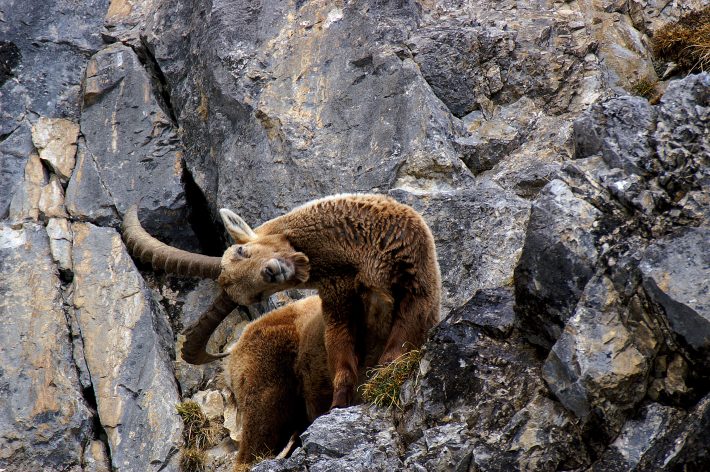Hunters prefer ibex with long horns
WSL press release
It is hardly surprising that hunters prefer shooting ibex with longer-than-average horns. What is more striking is that hunting strong ibex does not affect the remaining herds, as demonstrated by an international study involving the Swiss Federal Institute for Forest, Snow and Landscape Research (WSL).

A study published in the Journal of Animal Ecology reveals that ibex with longer-than-average horns are more likely to be shot than animals of the same age with shorter horns. It found that the horns of ibex shot at age 13 and older were up to 5 cm longer than the horn-length produced in 13 years and more of other animals killed at a higher age. However, regulations set limits for hunters: they are only allowed to shoot a certain number of animals within an age group covering several years. The figures show that hunters play it safe.
Within an age group, they tend to shoot ibex with longer-than-average horns. At the same time, they try to minimise the probability of violating the rules by shooting as few animals as possible with the minimum and maximum horn length at the upper and lower boundaries of the age group.
The international research team led by WSL and the University of Cambridge, together with the Canton of Graubünden’s Hunting and Fishing Authority, investigated the horn growth of ibex killed between 1978 and 2013 in Graubünden. The researchers analysed the criteria used by hunters to select their prey and whether horn growth or body weight had changed in the 8,355 ibex shot over the last 40 years. These characteristics enabled the team to draw conclusions about the survival probabilities of individual animals and herds.
Animals’ vitality does not suffer
“The most important finding is that ibex hunting over the last 40 years has not had a negative effect on the constitution of the animals,” says WSL’s Kurt Bollmann. The good news for hunting and nature conservation is that horn growth in Graubünden’s ibex has not reduced over the decades and their average body weight has also remained the same, even though hunters prefer strong animals in this respect as well. “We are very happy that the knowledge gained in practice about our ibex herds has now been scientifically verified and that ibex hunting in Graubünden can be described as sustainable,” adds Hannes Jenny from the Graubünden Hunting and Fishing Authority.
The goals of hunters and the relevant authorities do not fully align. While hunters often select animals based on their age and gender or the quality of the meat and their worthiness as a trophy, the hunting authorities would like to keep the size of individual herds at a level that ensures the protective function of forests and does not cause a large number of these wild animals to die in winter. Regardless of these interests, the most important point from a wildlife biology perspective is that hunting does not negatively affect the population of the hunted wild animal in the long term.
As a formerly extinct species, the Alpine ibex is closely monitored in the Alpine region. It is regarded as one of the flagships of Swiss nature conservation. A particularly close watch is kept on ibex hunting because this species has a long lifespan and relatively low reproductive performance, meaning that uncontrolled hunting could negatively affect the animal population. Therefore, in Graubünden, where around 40% of Switzerland’s ibex live, a hunting regulation was passed stipulating that each hunter may only bring down one female and one male in a particular age group every 10 years. If a hunter violates this requirement, for example by shooting an older animal with longer horns, he/she has to pay a fine and the bag is confiscated by the canton.
Read the full article (freely available for a limited time):
Büntgen U, Galván JD, Mysterud A, et al. Horn growth variation and hunting selection of the Alpine ibex. J Anim Ecol. 2018;00:1–11. DOI: 10.1111/1365-2656.12839
Media contact:
Reinhard Lässig, Media Relations, Eidg. Forschungsanstalt WSL, Email: reinhard.laessig@wsl.ch, Tel: +41 44 739 2389
Like what we stand for?
Support our mission and help develop the next generation of ecologists by donating to the British Ecological Society.